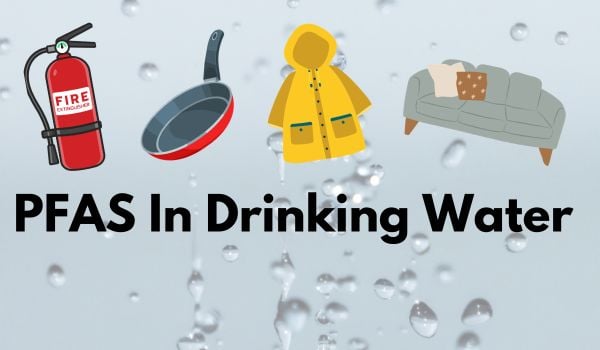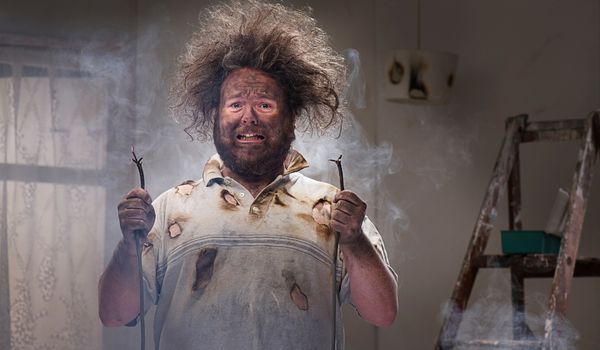If you’re worried about “forever chemicals” sneaking into your tap water, you’re not alone.
Quick answer?
✅ Yes, reverse osmosis (RO) systems can significantly reduce PFAS — often removing up to 99% of certain types. But not all systems are created equal, and maintenance matters to keep that protection strong.
In this guide, we’ll break it all down —
- 👉 how RO filtration works,
- 👉 why it’s one of the top defenses against PFAS,
- 👉 and how to choose a system that’s worth your investment.
Let’s dive into it. 💧
🧠 Quick Takeaways
- ✅ Reverse osmosis can remove up to 99% of PFAS like PFOA and PFOS.
- ✅ Filter quality, maintenance, and water conditions affect results.
- ✅ Not all RO systems are optimized for PFAS — choose carefully.
- ✅ Testing your water helps fine-tune your filtration strategy.
- ✅ Pairing RO with a second system (like a whole-house filter) offers even stronger protection.
🧬 What Are PFAS? (And Why They’re Tough to Filter)

Quick answer?
✅ PFAS are a group of stubborn, man-made chemicals — including GenX, PFBS, PFHxS, PFBA, PFOS, and PFOA — that don’t break down easily in the environment (or your body). Filtering them out isn’t simple — they’re designed to resist water, heat, and even chemical treatment.
PFAS Explained: PFAS (per- and polyfluoroalkyl substances) were invented back in the 1940s to make life easier — non-stick pans, waterproof jackets, grease-resistant food wrappers — you name it.
Fast-forward to today, and they’ve overstayed their welcome:
- Found in drinking water across the U.S.
- Linked to health issues like: hormone disruption, immune suppression, and certain cancers.
- Extremely tough to filter out because they’re small, slippery molecules.
💬 Good to Know:
PFAS don’t have a “half-life” like many contaminants — they accumulate slowly in your body over time. Even low exposures can become a big health concern after years of daily intake.
🛡️ How Reverse Osmosis Blocks PFAS

Reverse osmosis (RO) is one of the few proven ways to slash PFAS levels in your drinking water — and it’s surprisingly simple once you break it down.
- ✅ What It Does: RO systems push water through a semi-permeable membrane that acts like a microscopic bouncer — letting clean water through while blocking sneaky contaminants like GenX, PFOS, PFHxS, and PFOA.
- ✅ Why It Works: PFAS molecules are big and stubborn. RO membranes are picky — they force water molecules to pass but trap nearly everything larger, including many “forever chemicals.”
- ✅ What Gets Removed: Independent studies (and EPA guidance) show RO can remove up to 90–99% of common PFAS compounds — way better than most basic carbon filters.
| 🔍 Feature | 💧 Why It Matters |
|---|---|
| Membrane Precision | Filters down to 0.0001 microns — small enough to catch PFOS, PFOA, PFHxS, and more |
| Multi-Stage Filtration | Sediment + carbon pre-filters protect the membrane and boost effectiveness |
| Storage Tank | Holds purified water because RO is slow — pure water, always ready |
| Dedicated Faucet | Dispenses only purified water — keeps it separate from regular tap water |
💬 Good to Know: RO filters don’t always remove every trace of every PFAS — but they’re currently one of the strongest tools available for home use, especially when combined with pre-filters that tackle chlorine and organics (which can gum up the RO membrane over time).
🧪 My Experience Fighting PFAS

When my hometown water report finally hit my inbox, it wasn’t great. ⚠️
PFAS — including GenX, PFOS, PFOA, PFBS, and PFHxS — were all detected, even though the report said levels were “within limits.” Legal? Maybe. Safe for my family? No thanks.
That’s when I decided to take things into my own hands.
- ✅ Water Testing First: I sent a sample to SimpleLab’s Tap Score service to get a full PFAS breakdown. (Pro tip: standard city water reports often miss critical PFAS chemicals.)
- ✅ Choosing the Right RO System: After digging deep into real-world performance, I chose the Waterdrop G3P800 reverse osmosis system. It’s independently tested and offers up to 99% PFAS removal — including the ones that scare me the most like PFOS and PFOA.
- ✅ Tasting the Difference: After installation, the taste test said it all — crisp, fresh, no weird chemical aftertaste. Just clean, safe water from every sip.
💬 Good to Know: PFAS aren’t always obvious — they build up in your body over time. That’s why choosing a system verified for specific PFAS removal matters (not just “better taste” claims).
Of course, taste only tells part of the story. To be sure, I ran a dedicated Tap Score PFAS panel on my Waterdrop G3P800. The results? Every single one of the 14 analytes came back Not Detected (ND).
Here’s the before-and-after data compared to my baseline city tap water:
🔬 Tap Score Lab Results — Waterdrop G3P800 Tankless RO (PFAS Panel)
| PFAS Analyte | Before (City Tap) | After Waterdrop RO | Change |
|---|---|---|---|
| PFOA ⓘEPA Health Advisory: ~0 ppt (essentially zero) | Detected traceTap | Removed ND | −100% |
| PFOS | Detected traceTap | Removed ND | −100% |
| PFHxS | Detected traceTap | Removed ND | −100% |
| PFNA | Detected trace | Removed ND | −100% |
| Other PFAS (10 additional) | Detected trace | Removed ND | −100% |
Context & Methods
“ND” = Not Detected above Tap Score reporting limits (0.00053–0.001 µg/L depending on analyte). All 14 PFAS analytes in the panel tested Not Detected after treatment.
Usage & test conditions: The Waterdrop G3P800 tankless RO had filters and RO membrane recently replaced prior to sampling, followed by a thorough system flush, to ensure valid performance results at the time of testing.
Pre-test (City Tap, baseline):
View baseline lab report (Tap Score)
Post-test (after Waterdrop G3P800, with new filters):
View PFAS lab report (Tap Score)
Show full PFAS panel (14 analytes)
All analytes above were Not Detected (ND) at Tap Score reporting limits. See the full PDF for exact MDLs: PFAS report.
💧 Tap Score Essential City Water Results (Aug 2025)
Key Findings (Report ID: DFPVIM):
- TDS: 28 mg/L (very low)
- Hardness: 5.2 mg/L (≈0.3 gpg, very soft)
- pH: 7.2 (neutral)
- Metals (lead, arsenic, chromium, copper, cadmium, mercury): ND
- Fluoride & Nitrate: ND
- Sodium: 9.8 mg/L (normal trace from RO process)
Full report available here: View Essential City Water lab report (Tap Score)
When the results came back all clear, it honestly felt like a weight off my shoulders. No PFAS, nothing lurking in the background — just clean water I don’t have to second guess.
🏠 Whole House Protection Against PFAS

Filtering your drinking water is a huge step — but what about the water you bathe in, cook with, or use every day? 🤔
Since PFAS aren’t just a problem at the faucet, I added another layer of defense:
the Springwell CF1 whole house filtration system.
- ✅ Why I Chose It: Springwell’s CF1 doesn’t just improve taste — it’s designed to tackle a broad range of contaminants, including PFAS compounds like PFOA, PFOS, and others.
- ✅ Whole-Home Coverage: Every drop of water — from the shower to the dishwasher — gets a major quality upgrade.
- ✅ Peace of Mind: Adding a whole-house filter means I’m not just protecting drinking water — I’m shielding my entire home from hidden chemical exposure.
💬 Good to Know: No single filter catches everything. Combining a whole-house system plus a dedicated reverse osmosis system at your sink gives you full-spectrum protection against the widest range of threats.
| 🏠 Protection Type | 💧 What It Covers | ⚡ Key Benefits |
|---|---|---|
| Whole-House Filtration | All water entering your home (showers, sinks, washing machine) | Reduces PFAS, chlorine, sediment, and improves water quality everywhere |
| Reverse Osmosis System | Drinking and cooking water at a single tap | Targets PFAS like PFOA/PFOS, heavy metals, and microscopic contaminants |
| 🛡️ Combined Approach | Full-house protection + ultra-pure drinking water | Maximizes contaminant removal at every faucet and protects sensitive taps |
💡 Pro Tip: Pairing a whole-house filter with a reverse osmosis system gives you the best of both worlds — cleaner water for everything you do and ultra-pure water where it matters most. Total home peace of mind! 🛡️
See our full list of PFAS filters.
🔬 How Effective Is RO at Removing PFAS?

After years of testing, research, and dealing firsthand with PFAS concerns, I can confidently say this:
Reverse osmosis isn’t just marketing hype — it’s one of the few real defenses we have.
But like anything, it’s not a magic bullet. Let’s break it down:
- ✅ RO Membranes = PFAS Bouncers: High-quality RO membranes can reject a wide range of PFAS contaminants — often cutting levels by 90–99% depending on the system.
- ✅ Upkeep Matters: Even the best RO system will struggle if you neglect filter changes, membrane flushes, or regular maintenance. A clogged or exhausted membrane can let contaminants sneak through.
- ✅ System Quality Counts: Not all RO units are created equal. Systems with strong third-party test results and advanced filtration designs consistently outperform cheaper models.
- ✅ Location & Water Quality Play a Role: If you’re dealing with high PFAS levels or a mix of chemical types, you may need extra pre-filters or pair RO with a dedicated PFAS filter system for full protection.
💬 Good to Know: Reverse osmosis doesn’t just help with PFAS — it also removes heavy metals, nitrates, pesticides, and hundreds of other microscopic contaminants in one system.
🚧 Reverse Osmosis Limitations

Reverse osmosis (RO) systems are powerful — but like any technology, they’re not perfect. Knowing the limitations up front helps you get the best long-term performance (and avoid disappointment). Here’s what you should know:
- ✅ Pre-Filters Matter: If the sediment or carbon pre-filters aren’t replaced regularly, they can clog up fast — putting extra strain on the delicate RO membrane. Maintenance really isn’t optional.
- ✅ Membranes Aren’t All the Same: Not every RO membrane is created equal. Some are better at targeting stubborn chemicals like GenX, PFOS, and PFOA. If PFAS removal is your goal, you’ll want a high-rejection membrane designed to handle it.
- ✅ Water Pressure Plays a Role: Low water pressure can slow filtration to a crawl — or worse, reduce contaminant rejection rates. If your pressure’s too low, a booster pump might be necessary for peak performance.
- ✅ Efficiency vs Waste: Traditional RO systems send 2–3 gallons of water down the drain for every gallon of purified water. Newer models (like the Waterdrop G3) have improved this a lot — but it’s still something to consider.
- ✅ Taste Isn’t Always the Best Guide: Just because your water tastes better doesn’t mean all PFAS are gone. Some contaminants are tasteless — that’s why testing and maintenance matter.
💬 Good to Know: A properly installed, properly maintained RO system can remove up to 99% of PFAS like PFBS, PFHxS, and PFBA — but without regular upkeep, even the best system can lose effectiveness fast.
🎯 How to Choose the Right RO System

Picking a reverse osmosis system isn’t just about cool features — it’s about finding one that’s proven to filter out tough contaminants (like PFAS) and fits your home and budget. Here’s what really matters when you’re choosing:
| 🔍 Feature | ⚡ Why It Matters |
|---|---|
| PFAS Removal Proof | Check for real-world results — not just marketing claims. Look for systems like the Waterdrop G3 that show tested PFAS reduction. |
| NSF/ANSI Certifications | Third-party verified systems guarantee performance against specific contaminants — not just basic filtration. |
| Filter Lifespan & Cost | Longer-lasting filters save money and reduce maintenance hassles over time. |
| Water Efficiency | Choose modern RO systems with better water-to-waste ratios to cut waste and save money. |
| Maintenance Ease | Systems with easy-change filters and simple maintenance reminders make life easier (no plumber required). |
| Size & Fit | Make sure it fits your under-sink space with room for airflow and easy filter access. |
💬 Good to know: When it comes to picking an RO system, don’t get distracted by bells and whistles. Focus on certified PFAS reduction, filter life, and ease of maintenance — and you’ll get cleaner, safer water without the headaches. 🌟
🛠️ Installation and Maintenance

Installing and maintaining a reverse osmosis system isn’t rocket science — but doing it right ensures you get maximum PFAS protection and clean, great-tasting water for years to come. Here’s a simple breakdown of what to know:
| 🔧 Step | ⚡ Key Tips |
|---|---|
| ✔️ Install Smart | Follow the manual carefully. If you’re drilling into stone counters, consider a pro. Otherwise, most systems like Waterdrop G3 are DIY-friendly. |
| ✔️ Check All Parts | Before you start, lay out all pieces. Missing anything? Call the manufacturer before halfway through the install. |
| ✔️ Plan for Access | Leave space around your system for easy future filter swaps — trust us, you’ll thank yourself later. |
| ✔️ Replace Filters on Time | Set a reminder! Waiting too long leads to lower PFAS removal and slower water flow. |
| ✔️ Sanitize Annually | Once a year, clean the system with a safe sanitizing solution to prevent bacteria buildup inside. |
| ✔️ Monitor Water Pressure | Low flow or weird tastes? Might be time to change filters or check for clogged tubing. |
💬 Pro-tip: An RO system doesn’t need constant babysitting — just a little TLC now and then. Stay on top of basic maintenance, swap filters on schedule, and you’ll keep enjoying cleaner, safer water without the drama. 🧽💧
🔍 Troubleshooting Common Issues

Even the best reverse osmosis systems occasionally need a little troubleshooting. Catching small problems early helps avoid bigger headaches (and keeps your water quality top-notch). Here’s a cheat sheet for common issues and quick fixes:
| ⚡ Problem | 🔧 Quick Fix |
|---|---|
| 🚿 Slow Water Flow | Check water pressure, replace clogged pre-filters, and inspect for pinched tubing. |
| 💧 Leaks Around Fittings | Double-check connections. Hand-tighten fittings (no tools needed) and replace O-rings if cracked. |
| 👃 Weird Taste or Odor | Change post-filters. Flush the RO membrane if taste persists after a filter swap. |
| 📉 Low Tank Pressure | Use a gauge to check tank psi (should be ~7–8 psi when empty). Repressurize if needed. |
| 🔵 Tank Not Filling | Look for a clogged RO membrane or flow restrictor. Replace if cleaning doesn’t solve it. |
| 🔁 System Constantly Running | Check the automatic shut-off valve. If faulty, replace it to stop wasting water. |
🛠️ Minor issues are easy to fix once you know where to look! Staying alert for early signs of trouble means you’ll keep your system (and your water quality) flowing strong without needing expensive repairs. 👊💧
🧠 Final Thoughts
Reverse osmosis isn’t just hype — it’s one of the few proven ways to tackle stubborn contaminants like PFAS. 💪
- ✅ A well-maintained RO system can reduce up to 99% of these “forever chemicals.”
- ✅ Smart filter changes and regular water testing keep your system performing its best.
- ✅ Not all systems are equal — choosing the right one makes all the difference.
💬 Bottom line?
If you want real protection for your drinking water, reverse osmosis is a game-changer — and staying proactive with maintenance ensures it keeps fighting for you, glass after glass. 💧
Cheers to clean, worry-free water! 🥂✨
 146 people found this helpful. Was this guide helpful to you?
146 people found this helpful. Was this guide helpful to you? 

